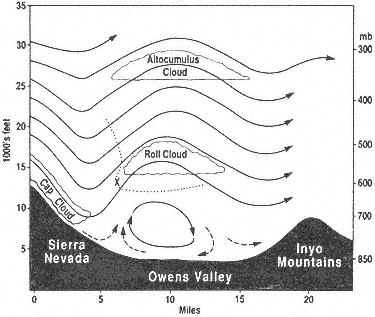Sine wave in the sky over Singapore
By Murray Bourne, 23 Feb 2008
I had a friend who was heavily into gliding. He would become very excited when he observed "wave" in the sky.
Gliders (aka sailplanes) don't have engines, of course, so you spend all your time looking for lift.

[Image source: Boeing]
The lift comes from thermals (rising hot air, usually over dark-colored ground) or waves that are the result of wind blowing over mountains. When airflow is lifted by a mountain range, it is called 'orographic uplift'.

[Image source, from Natural History of the White-Inyo Range, Eastern California.]
So in gliding, "wave" is a standing sine curve on the leeward side of a mountain.
I saw the following wave pattern over Singapore recently. The clouds are much higher than where gliders can reach, but there is evidence of alternating rise and fall of the moist airmass. In this case, the wave could be the result of air passing over mountains in Indonesia (there are no mountains in Singapore).

[Photo: LimPH].
See the 4 Comments below.
2 Mar 2008 at 10:08 pm [Comment permalink]
My nephew Harald Boetz, who lives in The Hague Holland, like to sail plane in Germany around the high mountains. He knows about the rising winds and how to use them. Here where I live at the North Carolina coast in USA I always observe with great interest how the eagles and other big birds can just sail de sky, without flying, for hours. Nature has that all figured out.
3 Mar 2008 at 12:12 pm [Comment permalink]
Yes, Johan, and the carbon footprint of that sail plane (and of the eagles) is very low.
Not so with your average jet...
4 Mar 2008 at 1:12 am [Comment permalink]
I suddenly remember. We lived on the sloop of the Tangubanprau north of Bandung. age 13 (1937). We had an original English tennis court. I loved to fly kites. Also to make all kinds of little airplains out of paper. Often the airplanes would take to the air and rose and rose and flew by themself sometimes as long as ten to 15 minutes. The wind striking over Bandung (Preanger valley) Would rise up the mountain slope and caused that feat. The wind touching you, however, would not give that indication. Flying kites in Indonesia means fighting kites. One would fly ones kite far away over a village and then the kite gets attacked by several enemy kites. Very exiting. Complicated manoeuvring and trying to cut the enemies glass coated line with ones own. Good memories.
2 Jan 2011 at 7:19 pm [Comment permalink]
I had a friend who was heavily into gliding. He would become very excited when he observed